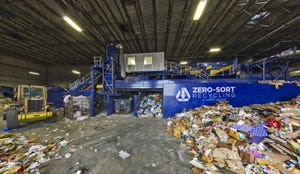Priming the Alternative Pump
The $787 billion economic stimulus package should ease the switch to alternative fuels.

There's something for everybody in President Obama's newly minted American Recovery and Reinvestment Act (ARRA). The $787 billion package, which was signed into law on Feb. 17, clocks in at 1,073 pages and salts money in every corner of the U.S. economy, from education ($21 billion for school modernization) to expanded Internet service ($6 billion to bring high-speed service to rural and underserved areas). There's even a cool $1 billion to fund the 2010 Census.
Furthermore, for refuse fleets looking to make new or expanded investments in alternative fuels, the ARRA offers both direct and indirect aid. For starters, the president's economic stimulus package provides $300 million in grants to enable state and local governments to buy alternatively fueled buses and trucks. So for public refuse fleets, the door is now wide open to a range of different power options for their vehicles — natural gas, biodiesel, etc. Private refuse fleets could benefit indirectly from this funding if public fleets start placing large orders for alternatively fueled trucks, as rising sales volumes should help reduce vehicle sticker prices.
The solid waste sector should also benefit indirectly from the $2.5 billion slotted for the research and development of renewable and more efficient energy technologies. This will impact vehicles as well as power plants, homes, and industrial and commercial buildings.
The biggest direct impact that refuse fleets of all stripes will see from the ARRA is a $300 million fund for heavy-duty diesel vehicle and equipment owners to retrofit their fleets. This funding for the Diesel Emissions Reduction Act (DERA) will be administered by the U.S. Environmental Protection Agency (EPA) and represents a six-fold increase from last year's $49.2 million funding level, according to Allen Schaeffer, executive director of the Diesel Technology Forum in Frederick, Md.
“This funding represents a bold new investment in clean diesel technology that will be good for our economy and our environment,” he says. “Now the challenge will be to help applicants prepare good project proposals for what will likely be an expedited application process. Applicants for these funds should move quickly to develop an application since time is of the essence, with EPA's application process only open for a period of 30 days.”
DERA funding is available for on- and off-road diesel projects encompassing one of the “five R's” of retrofitting: rebuilding engines, repowering or replacing engines, replacing entire vehicles, refueling with cleaner fuels or retrofitting with emissions control technologies. Private sector applicants cannot apply directly, but can partner with state and local governments or a non-governmental organization.
Tax Credits, Too
Spending is not the only way the stimulus package is bolstering alternative fuels. A range of tax credits is being deployed as well.
A fund of $54 million is earmarked to provide a 50 percent tax credit for the purchase of alternative fuel refueling stations, with more than $13.1 million set aside to extend the placed-in-service renewable energy investment credit for three years. Another $285 million is earmarked for credits for investments in alternative energy plants.
The tax credits are part of Obama's effort to encourage wider and faster growth of the alternative fuels market as a way to decrease the nation's reliance on imported petroleum for both environmental and security reasons. “This plan will begin to end the tyranny of oil in our time,” Obama said in a speech at the Department of Energy (DOE) in early February. “After decades of dragging our feet, this [stimulus package] will finally spark the creation of a clean energy industry that will create hundreds of thousands of jobs over the next few years — manufacturing wind turbines and solar cells, for example — [and] millions more after that. These jobs and these investments will double our capacity to generate renewable energy over the next few years.”
As he noted in the energy policy statement issued after his inauguration, encouraging growth in alternative fuels also alleviates the security concerns that come from overreliance on imported oil. The United States imports more than 50 percent of its petroleum supplies, much of it from hostile nations.
“Our nation is confronted by two major energy challenges: our dependence on foreign oil and global climate change, both of which stem from our current dependence on fossil fuels for energy,” Obama said in his DOE speech. “We have a moral, environmental, economic, and security imperative to address our dependence on foreign oil and tackle climate change in a serious, sustainable manner.”
He said advances in biofuels — including cellulosic ethanol, biobutenol and other new technologies that produce synthetic petroleum from sustainable feedstocks — offer tremendous potential to break the country's addiction to oil. “We will work to ensure that these clean alternative fuels are developed and incorporated into our national supply as soon as possible,” the president said. “We will require at least 60 billion gallons of advanced biofuels by 2030. We will invest federal resources, including tax incentives and government contracts, into developing the most promising technologies and building the infrastructure to support them.”
“President Obama clearly understands the threat foreign oil dependency has over us — bankrolling dictators, unwillingly supporting nuclear proliferation, and funding both sides of the war on terrorism,” noted Dallas-based oil and natural gas baron T. Boone Pickens in a conference call he held to discuss the Obama administration's approach to energy. “A program focused on renewable energy, conservation, improving the grid and replacing foreign oil with domestic resources in our transportation system is something that I believe will create hundreds of thousands of jobs, revitalize our economy and enhance our homeland security.”
Sean Kilcarr is a senior editor of Fleet Owner, a sister publication of Waste Age.
Eye on Biodiesel
Besides being relatively easy to use, refuse fleets have another reason to keep biodiesel on their radar: the federal government has mandated increased production and use of the fuel over the next three years.
“The Energy Independence and Security Act of 2007 calls for 500 million gallons of B100 [a fuel made entirely of biodiesel) to be produced by this year, rising to one billion gallons by 2012,” says Professor Tim McDonald of Auburn University's Center for Bioenergy and Bioproducts. “Also, no alternative fuel is as easy to use as biodiesel for trucks. It's a liquid, so the distribution infrastructure is already in place, and trucks can start using it right away with few modifications. “
“As America searches for solutions to our energy challenges, U.S. biodiesel is delivering a cleaner and sustainable renewable fuel source,” said Emily Landsburg, chair of the Jefferson City, Mo.-based National Biodiesel Board's Sustainability Task Force, in a press release. “Biodiesel is already helping the nation make important strides toward energy independence, and we will continue to explore new and promising practices.”
Oil Import Break Down
So how much oil does the United States import and from where? According to data compiled by the Energy Information Administration, an arm of the U.S. Department of Energy, the United States is the world's third largest crude oil producer, yet less than 35 percent of the crude oil used by U.S. refineries was produced here.
Petroleum imports accounted for 58 percent of our total petroleum consumption, with about 48 percent of our petroleum imports from countries in the Western Hemisphere, 18 percent from the Persian Gulf, 22 percent from Africa and 12 percent from other regions.
About the Author
You May Also Like


